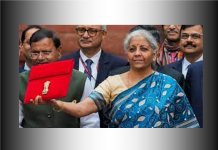
There are no two opinions that this years’ budget is slightly different from the format we have been witnessing over the last few decades. As opposed to the general trend of populism exercise on a significant election time, there was no appeasing announcements. Similarly, there was no sentimentalism of the agricultural sector which is the habitation for nearly 60 crore people despite the pleasurable fact that there is strong continuation of the abundant number of measures for the sector.
Now, given this background, this budget contained a large number of policies aimed for addressing the opportunities and challenges of the current economic environment. Several initiatives that the budget has given attention are related with the transformation areas of the economy – the digital sector. Remarkably, there is a large number of digital economy initiatives that can facilitate education, enterprise development, employment generation, production and exports. Here are the ten major areas where the FM has made courageous steps through this budget.
- The digital age budget: If one area or focus is to be chosen for this years’ budget, for outstanding focus, it is digital economy. There is no denying that the infrastructure under PM Gati Sakthi is getting the conventional type of focus. Still, the number of novel initiatives and the deep and minute attention given to the various subsectors, the digital economy initiatives in the budget are remarkable. Following are some of the initiatives in digital economy.
(i) Digital Rupee
(ii) Tax on income from virtual digital assets.
(iii) Digital university for providing educational content
(iv) Digital Banking Units: 75 Digital Banking Units (DBUs) in 75 districts of the country by Scheduled Commercial Banks.
(v) Support to AVGC sector: A task force will be set up for Animation, Visual Effects, Gaming and Comic (AVGC) sector.
(vi) e-bill system for the various ministries: a completely paperless, end-to-end online e-Bill System for all central ministries for their procurements.
- Bold steps to encourage the growth engine of the economy-the manufacturing sector: the PLI Scheme is extended to solar modules (Rs 19500 cores) and 5G infrastructure. Tax concession deadline has been extended to startups and the concessional 15% tax for new manufacturing units will be extended to March 31st, 2023. Tax concessions for imports are there for manufacturing sector for the production of electronic items. For the capital goods sector, new tax incentives are declared.
- Capital expenditure enhancement is the lead story: Understand the productive capital expenditure spending in the last three decades was around just 12% of the budgeted expenditure till 2020. In the last year, it has been increased to 15% and now the budget allocates 19% of the total budget allocation for capital expenditure. The budgets’ total expenditure is Rs 39 lakh crores and out of that Rs 7.5 lakh crore is allocated for capital expenditure.
- No ban on crypto currency: Finally, the government’s dilemma on crypto assets is over. The FM announced an income tax of 30% on crypto assets. Admirers of cryptos exaggerates that there are nearly 10 crore indian investors in crypto assets. Here, the move to a simple income tax rather than capital gains tax and other types of taxes is the best method. More than that, banning the crypto is also avoided despite regulatory arguments for banning them.
- Education gets the highlight again: allocation to the sector increased by 11.6% compared to the total budgeted expenditure increase of 4.6%. This means that the budget has given higher allocation to the sector and several schemes especially digital education got the required attention amidst fund scarcity.
- Good work on several areas to be continued: the budget extended the good work the government has made on several areas. Incorporation of norms for cross border insolvency will be done by an amendment of the IBC Act. Exit for the companies will be made quick in six months to facilitate ease of doing business. ECLGS which was the ace support measure for the MSME sector will continue by adding Rs 50000 crore and thus the scheme will get a total fund allocation of Rs 5 lakh crore. River linkage, skill initiatives etc. continues to get budgetary attention.
- Bold and surprising steps: there will be few bold as well as surprising steps in every budget. These types of measures will be otherwise seeming to be very progressive and the following are some of them.
- Defence R&D: Opened to industry, startup and academia.
- Foreign universities can establish in GIFT city without regulatory requirements.
- Core banking solution in 100 Post offices and fund transfer with banks are allowed.
- The lead story: PM Gati Shakti-multimodal interconnectivity facilities with rail, road, port and other infrastructure facilities is the main theme of the budget. The Gati Shakti also integrates the national infrastructure pipeline. Infrastructure always has been a core areas of budget making. Still, the diverse steps announced under the budget for the sector makes infrastructure as the most funded and attended sector in this budget.
- Taxation area has not been changed: Understandably, the least touched area in this budget is taxation. This is because the tax structure is almost fine-tuned. What we can expect was the increase in exception limit for marginal taxation ie, higher income slab in personal income tax. Here, the 30% tax rate is applicable for people with income of above Rs 10 lakh since 2015. At the same time, the value of money has declined. The exemption limit remains at Rs 2.5 lakh since 2012. All this means that the government is not ready to touch taxation as it may bring down its revenues especially in a year where the government is financing Rs 17 lakh crore of its Rs 39 core expenditure out of borrowing.











